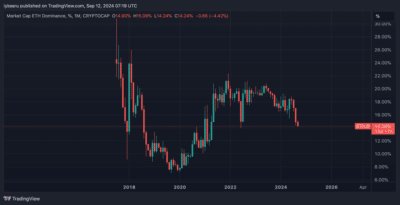Ethereum’s market dominance has hit a new low, dropping to 14.24%, its weakest level since June 2022. According to data obtained from TradingView, Ethereum has been dropping its market share dramatically over the past several months. There are also signs from data indicating that Ethereum’s trading volume in decentralized exchanges has gradually declined from 42% in 2022 to 29% in 2024.

Source: TradingView
Analysts attribute Ethereum’s downturn to several factors, including decreased network revenue and heightened competition from other blockchains. Thus, developers are attracted to faster networks with higher transaction speeds than Ethereum. This change has contributed to an apparent user base transfer from Ethereum to newer blockchains.
Also Read: Vitalik Buterin Completes Final ETH Sale and Pushes for Enhanced Project Standards
Competition from Emerging Blockchains
We can observe that other networks, such as Solana, Aptos, and Sui, are emerging, and people are migrating from Ethereum. Some of these users, who once transacted in Ethereum, have migrated to these other platforms, affecting Ethereum’s activity and earnings. Developers also prefer these quicker blockchains for minting tokens due to Ethereum’s congestion and increased cost.
Coincidentally, Ethereum’s latest Dencun update to reduce the cost of fees has backfired. While the purpose of the upgrade was to lower the costs in the network, the integration of many layer-2 solutions occurred in the network. They attribute this to the realization that layer-2 protocols are indeed competition and, therefore, the need to reduce Ethereum transaction fees by 99% after the upgrade. This has made Ethereum’s external and internal problems intensify the problems Ethereum has faced.
Also, Ethereum is gradually giving way to other platforms in smart contract development. A recent VanEck report also shows that differentiated non-financial projects involving blockchains are increasingly hosted on more sophisticated blockchain DAOs like Helium and Hivemapper. This shift reflects Ethereum’s diminishing dominance as a platform for speculative activities and token development.
In summary, Ethereum’s market dominance has significantly decreased in 2024, dropping from 18.80% mid-year to 14.24% recently. The blockchain faces mounting challenges from rising competition and internal issues. How Ethereum adapts to these pressures will be pivotal in determining its future role in cryptocurrency.
Also Read: Vitalik Buterin’s Wallet Shows Continued Crypto Activity with 190 ETH Sale

